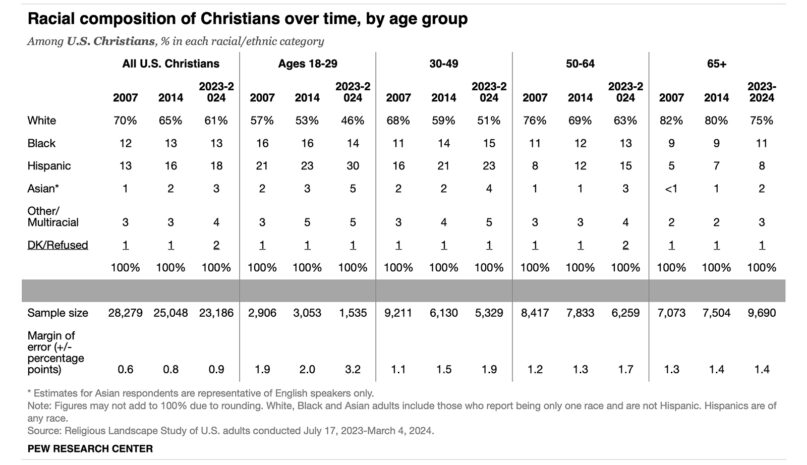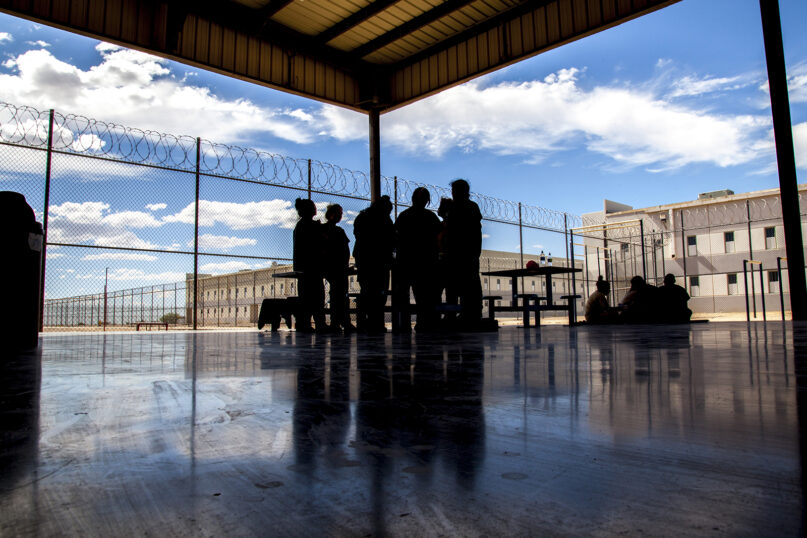
(RNS) — During his campaign to return to the White House, President Donald Trump promised to deport millions of undocumented immigrants and to shut down diversity programs in the federal government and higher education.
He also promised to restore Christians to power and religious faith to its rightful place in America.
“With your help and God’s grace, the great revival of America begins on Nov. 5,” he told a gathering of religious broadcasters in February of 2024.
Since taking office, Trump has sought to make good on those promises, launching a program of mass deportation and seeking to cut off funds to colleges and even houses of worship that have DEI programs.
His policies, however, may end up making America less religious, and in particular, less Christian, in the future. That’s in large part because younger white Americans are one of the least religious groups in the country — while nonwhite Americans and immigrants are among the most religious.
Fewer than half (43%) of white Americans ages 18-29 identify as Christian, with only half overall (51%) claiming any religious identity, according to data from the latest Pew Religious Landscape Study. Nearly half (48%) are religiously unaffiliated — meaning that among white Americans under 30, the so-called nones outnumber Christians.

“Racial composition of Christians over time, by age group” (Graphic courtesy of Pew Research Center)
By contrast, more than half (53%) of Black Americans and Hispanic Americans (54%) under 30 identify as Christian, while 60% of young Black Americans and 61% of Hispanic Americans identify as religious. Only younger Asian Americans (26%) and those from a multiracial background (42%) are less Christian than young white Americans. Still, young Asian Americans are more religious (53%), with 27% being affiliated with a non-Christian faith.
Among Americans between 30 and 49, only 27% of Black Americans are unaffiliated, while 31% of Hispanic Americans are unaffiliated. By contrast, 41% of Americans between 30 and 49 are religiously unaffiliated.
America’s Christian population has also become more diverse over time, according to Pew’s data.
In 2007, for example, 70% of all American Christians were white. By the latest study, with data collected in 2023-2024, that percentage had dropped to 61%. Among Christians over 65, three-quarters are white (75%), while 11% are black and 8% are Hispanic.
Among Christians under 30, only 46% are white, while 14% are Black and 30% are Hispanic.

The Rev. Gabriel Salguero. (Photo courtesy of The Gathering)
The Rev. Gabriel Salguero, pastor of The Gathering Place, a multiethnic Assemblies of God congregation in Orlando, Florida, said that without immigrants, many evangelical and Pentecostal denominations would be in trouble. The same would be true for the Catholic Church.
“If it were not for Latino immigrants and Asian immigrants and African immigrants, they would be on the decline,” said Salguero, who is also president of the National Latino Evangelical Coalition. He pointed to the Assemblies of God, which, like other Pentecostal groups, has been growing during a time when religion in America is on the decline.
According to Pew, about a third of the members of the Assemblies of God were either born outside the U.S. (22%) or have at least one parent born outside the U.S. (10%) — up from 23% in 2007. One in four is Hispanic.
Among U.S. Catholics, more than 40% are immigrants or children of immigrants (29% and 14%, respectively). More than a third (36%) are Hispanic.
By contrast, only 8% of Southern Baptists are either immigrants (6%) or children of immigrants (2%). The SBC, the largest Protestant denomination in the U.S., has experienced a steep decline over the past 20 years.
Salguero said that if Christianity is going to be revitalized in the U.S., immigrants, and especially Hispanic immigrants, will play a key role.
“Everybody’s talking about revival, but sometimes they fail to see the link between immigration and revival and the arrival of immigrants who are committed to the gospel,” he said. “The revitalization of U.S. Christianity, whether it’s Catholicism or evangelicalism, is in large part due to immigrants.”

Robert P. Jones. (Photo courtesy of PRRI)
Robert Jones, president of the Public Religion Research Institute and author of “The End of White Christian America,” which details America’s demographic changes, said that without immigration, the Catholic Church in the U.S. would have faced a steep decline.
He said Catholics have remained about a quarter of the U.S. population, despite the overall decline in religious affiliation, according to PRRI’s data. Without Hispanic immigration, largely from Mexico and Central America, “the number of Catholics in the country would essentially be half of what it is today.”
The immigration crackdown is already having an impact on religious practice, with some Hispanic Catholics and other Christians staying away from church out of fear of deportation.
Jones said revival among white Christians is unlikely — in part because the politics of those conservative churches, which lean Republican and oppose LGBTQ rights and other progressive causes, often clash with the values of younger Americans. In particular, he said younger women are disaffiliating from churches.
“There has been this culture clash between the stances of the more conservative white Christian churches and younger Americans,” he said.

Detainees at U.S. Immigration and Customs Enforcement’s Eloy Detention Facility in Eloy, Ariz. (Photo by Charles Reed/U.S. Immigration and Customs Enforcement)
That political clash is more prominent among young white Americans, who often do not believe it is possible to be religious and liberal, said author and political scientist Ryan Burge, a professor of practice at the John C. Danforth Center on Religion and Politics at Washington University in St. Louis.
“There’s space in nonwhite parts of American society to be liberal and be a person of faith,” he said. “That’s not as true for white Americans — for them, religion is inherently conservative.”
If cutting immigration makes Americans less religious, then why do so many Christians seem to support Trump’s plan for mass deportation?
The answer is that American Christians from different ethnic groups hold vastly different views about immigration and what it means to make America great again. Michael Emerson, a sociologist and author who has long studied the racial divides in American Christianity, said that among practicing Christians in the U.S., those who are white are the least likely to support immigration — legal or otherwise. That’s in part, he said, out of a desire to return to a time when white Christians were the dominant demographic in the country.
“If you are someone who believes that this country was founded as a Christian nation, you would think you would be open to all Christians,” said Emerson, a fellow in religion and public policy at Rice University’s Baker Center and co-author of “Divided by Faith” and “The Religion of Whiteness.”

Michael Emerson speaks during the Mosaix conference on Nov. 6, 2019, in Keller, Texas. (RNS photo/Adelle M. Banks)
“But what gets woven in is that a Christian nation is also a white or Western version of Christianity — and immigration gets in the way of that.”
Podcaster and conservative personality Tucker Carlson, known for his controversial takes on American culture — and his recent interview with antisemitic activist Nick Fuentes — has blamed immigration for the decline of religion in America.
But the reality is that America has become less religious — about 28% of Americans claim no religion — because white Americans are less religious. Most recent immigrants, Emerson said, are religious, and many are Christians.
America’s growing diversity among young people has already transformed college ministries such as InterVarsity Christian Fellowship, which had about 28,000 students involved in its small groups on campuses last year — and hosts the Urbana missions conference, which will be held in Phoenix in late December.

Greg Jao. (Photo courtesy of InterVarsity)
About 40% of the students involved with InterVarsity are immigrants or children of immigrants, said Greg Jao, senior assistant to the president of the ministry. And for the past five years, more than half the students involved in the ministry have been nonwhite.
That diversity reflects the demographics of the college campuses where InterVarsity works, said Jao.
“And it reflects the future of America, because while Gen Z is decades away from defining America, that’s what the future will look like,” he said.
He said the diversity of InterVarsity flows from the group’s theology.
“This is deeply grounded in our biblical commitments,” he said. “And so that doesn’t change, regardless of whether racial reconciliation and allied issues are popular or unpopular.”
Jao said the group’s diversity brings with it pastoral challenges. For example, he said, how do Hispanic students wrestle with Bible passages such as Romans 13, which instructs believers to “be subject to the governing authorities,” in a time of government crackdown on immigration?
Jao, who used to oversee InterVarsity’s work in New York, where many students were immigrants or the children of immigrants, said the ministry wants to reach people of all backgrounds.
“How do we reach the secularized, agnostic, atheist, white student in our midst?” he said. “Because we can’t be satisfied if they’re missing in the community as well.”
